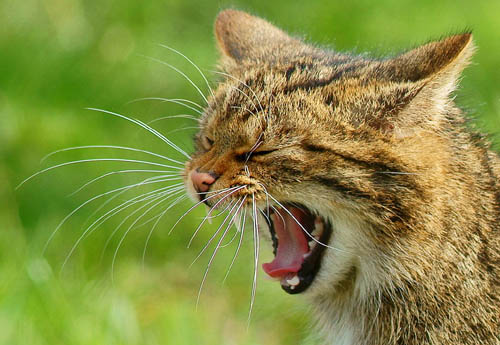ONLY 35 Scottish wildcats remain and they could be extinct within months.
Experts say the species is on the brink of extinction primarily as a result of interbreeding with their domestic cousins.
As a result only 35 purebred cats are believed to be left roaming their natural habitat in remote areas of the Highlands.

The Scottish Wildcat Association, the Cairngorms Wildcat Project and university groups analysed 2,000 records of camera-trap sightings, witness reports and roadkills.
They found that only 20 of these animals matched the striped coat markings of a true pureblood wildcat.
When the researchers put their findings next to the anticipated population of 3,500 cross-bred cats they found that there might only be 35 animals left in the wild.
According to the SWA this is happening because hybrid-offspring are mating with other wildcats, ferals and hybrids that create a range of different animals that might look similar but act differently.
Steve Piper, the founder of the SWA, said: “However you juggle the numbers it’s hard to find anything positive.
“The overwhelming evidence is that the wildcat is going to be extinct within months – anything else is blind hope.”
Mr Piper added that if they were to go by the reports of witness sightings then the outlook for the survival of the species is the even worse.
He said: “We’ve asked the leading experts in identifying wildcats to double-check opinions of our team and no one thought those animals were true wildcats.
“Apparently in the Cairngorms project if a hybrid looked close to a wildcat, then they were calling it a wildcat.
“The much-repeated phrase ‘expert-verified purebred wildcat’ was exceptionally misleading.”
The Scottish wildcat evolved after it was caught off from the rest of Europe at the end of the last Ice Age.
Its numbers drastically fell after it came under threat from deforestation and it was persecuted by gamekeepers in the 19th Century.
Genetics experts at he University of Chester are now trying to develop a DNA test that might help with protecting the seriously endangered animals.
Dr Paul O’Donoghue, senior lecturer in biology at the university, said: “Due to such difficulty in distinguishing pure wildcats from hybrids, there are currently no truly meaningful conservation activities being carried out to address the issue.
“The real issue is stopping hybridisation. We can only do that accurately with a genetic test which works off blood samples.
“Wildcats have to be live trapped and sampled.”
Scottish Natural Heritage said saving the wildcat was important but no plan can be launched to help save them until more is known about the dangers facing them.
A spokesman said: “We agree that the evidence points to wildcat populations being in a parlous state.
“However we need to be careful when drawing conclusions from subsamples and unverified records.
“The limited survey information available on this cryptic species provides an uncertain basis from which to state precisely how many animals may be living wild.”

